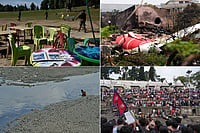For all stargazers, this is the best time to sit back and enjoy the night sky as one of the best meteor showers of the year is happening this week!
According to NASA, the Geminids meteor will hit its optimal viewing point Wednesday night into Thursday. And if the sky is clear, experts believe that skywatchers will be able to witness 120 shooting stars per hour.
When Geminids will be visible?
Known to be bright and fast meteors, Geminids usually appear yellowish or white, though they can also be green, red, and even blue. This year, most of the country is expected to have clear skies during prime viewing hours, which are expected to begin at 10:00 p.m. EST on December 13 and end at 7:00 a.m. EST on December 14.
What is the best way to watch Geminids?
The ideal position to see the Geminids, according to NASA, is to lie down or recline with your feet pointed south. The best spot for a vantage point is one that lets you see as much of the sky as possible, away from city lights and other forms of light pollution.
It's also recommended to give your eyes around thirty minutes to adapt to the darkness. Around 9 or 10 p.m. local time is when meteors will start to appear, but skywatchers who decide to head out even later—between midnight and 2 a.m.—may be in for a more spectacular view.
How were Geminids discovered?
Harvard astronomer Fred Whipple discovered a new cosmic object, 3200 Phaethon, on October 11, 1983. Initially thought to be a dead comet or rock comet, it was named after the Greek mythological god Phaethon. However, 3200 Phaethon is more than just a rock; it is the source of one of astronomy's greatest sky shows. The object takes about 1.4 years to make a single rotation through the solar system, leaving a dense tail of particles. The Earth moves through this debris trail annually in December, leading to the Geminids meteor shower, which was first observed in the mid-19th century.



























